Tiles for the kitchen on the apron: features, types and styling options
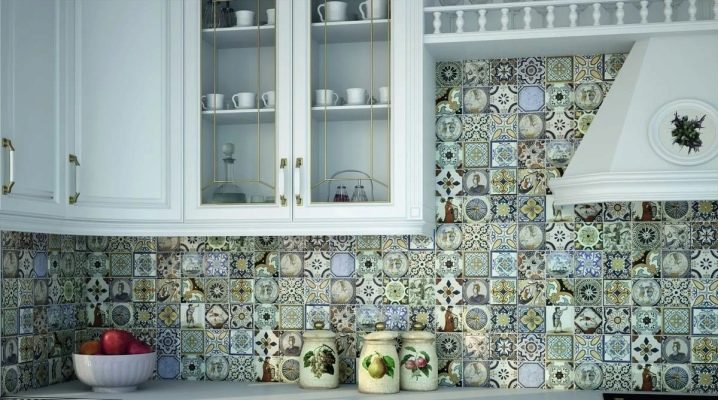
The design of the kitchen will be incomplete if you do not form a high-quality apron. It is often made from tiles. But before that, it is important to carefully study all the options and subtleties of such a coating.
Advantages and disadvantages
Facing tiles in the formation of aprons is a universal option. The resulting interior looks original. With the help of this technique, you can make the work area not only a pleasant component of the kitchen, but also its brilliant designer filler. But it is important to understand that the long service life is largely due to the complexity of dismantling. It is almost impossible to update the appearance, you will have to completely change the coating.
Ceramic coating works well with a wide variety of finishing materials. Therefore, it can be safely used in any environment. Quality tiles, regardless of their chemical composition, are environmentally friendly and do not provoke allergic reactions. In addition, sophisticated production technologies minimize the risk of microbial contamination and the appearance of fungal colonies. This is especially true for tiles that are subjected to high-temperature firing.
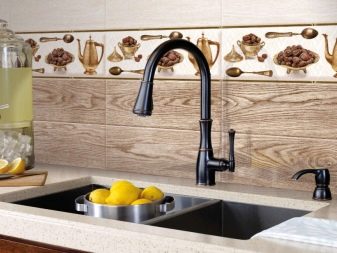

Varieties
Ceramic (otherwise called tiled) tiles are considered the most affordable material. At the same time, manufacturers have learned to produce such material in the widest range of colors and ornaments. Among them there are also extremely luxurious options. The tiles are divided into pressed and extruded. Pressing a mixture of clay and sand creates an excellent decorative material.
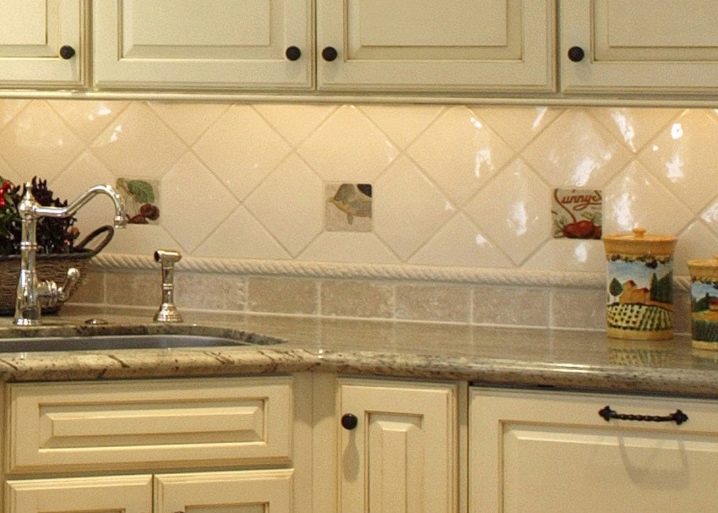
It is worth remembering that the tile can also have a so-called glaze, that is, a thin layer of glass on top. In this case, the slightest surface defects are extremely dangerous. Any cracks and punctures can either spoil the visual impression, or even completely damage the coating. It is glazed tiles that are best suited for wall decoration. In order not to be mistaken in choosing it, you need to carefully study all the designations and technical documentation.
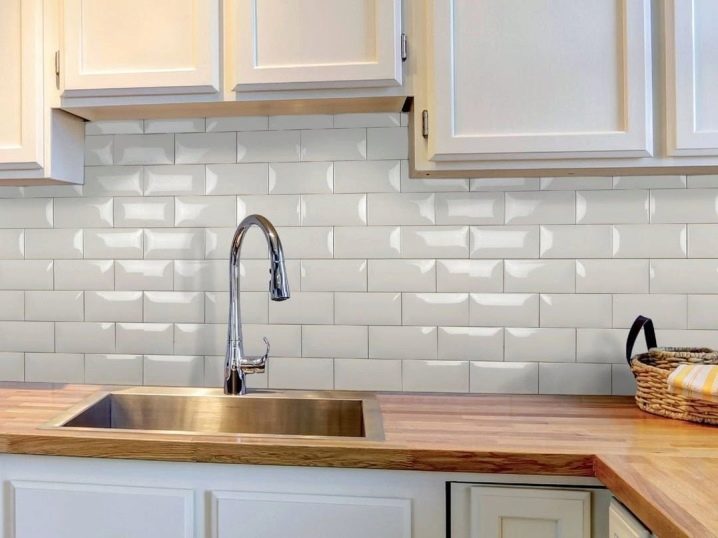
Glass tiles are used to form kitchen aprons a little less often than conventional ceramics. It harmoniously fits into any interiors modern in spirit. Along with the creation of complete compositions, this material proves to be an excellent addition for installation in specific locations. The glossy surface is easy to clean, and due to the reflection of light, it visually expands the room.
It should be remembered that water drops and splashes of fat will be immediately noticeable on such a tile.
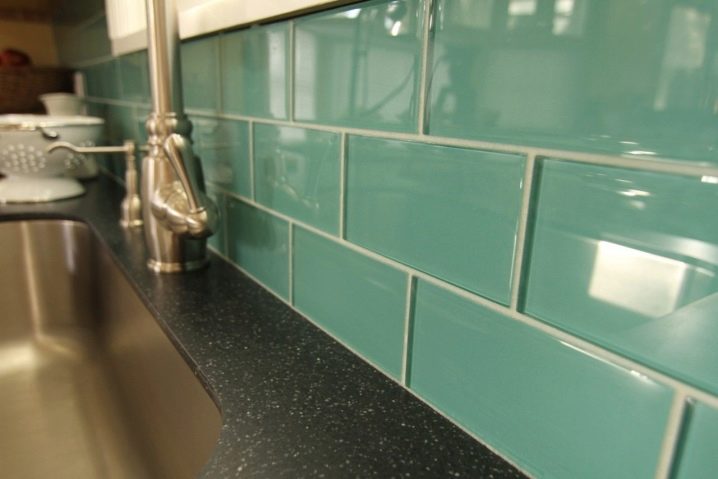
The combination of the characteristics of glass tiles makes it the best choice for small spaces. Regardless of other nuances of the interior, it creates a sense of sophistication and solemnity. The strength and water resistance of the material make cleaning easier. The peculiarity of the material is zero susceptibility to corrosive processes.
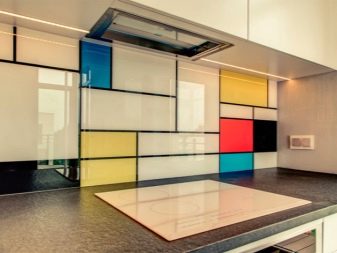
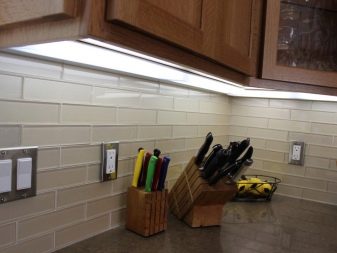
Mirror tiles can be used in any setting. Reflection of light is widely demanded by designers. After all, with its help, they can realize their ideas as freely as possible. Along with expanding the space, you can slightly improve its illumination. This is extremely important in the context of the continuous rise in electricity prices.
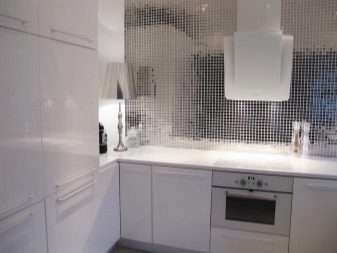

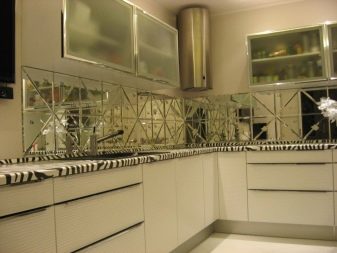
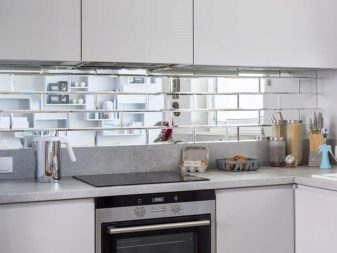
The undoubted positive aspects of mirror tiles are also:
high resistance to caustic substances and mechanical damage;
environmental and sanitary safety;
impressive design characteristics;
stable operation in a wide temperature range, regardless of the humidity level.
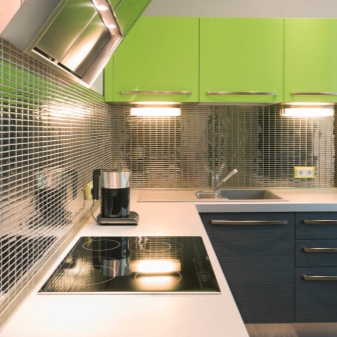
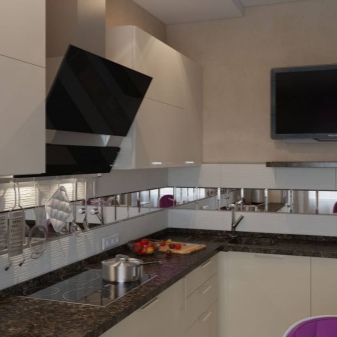
Attention should be paid to plastic tiles. The material used for its manufacture is completely safe and highly reliable. An important feature of this coating is long-term operation and ease of maintenance. Consumers can choose the most suitable option. In terms of the sum of its characteristics, it will show itself no worse than traditional solutions.
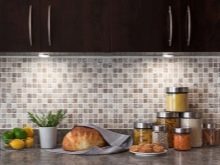

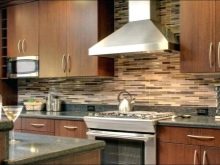
Completing the review is appropriate on porcelain stoneware tiles. In terms of chemical composition, ceramic granite is quite close to simple ceramics. The difference is clearly visible in the coloration. Ordinary ceramic tiles are painted with strictly colored coatings. Porcelain stoneware is treated with special pigments that are applied evenly. Therefore, it is possible to make tiles with the lowest possible porosity. As a result of a decrease in the number of pores, water absorption is also significantly reduced. This gives porcelain stoneware blocks a number of valuable properties, such as:
exceptional mechanical strength;
minimal susceptibility to wear and tear;
absolute protection from water;
excellent resistance to cold;
long period of operation;
lack of negative environmental and sanitary qualities.
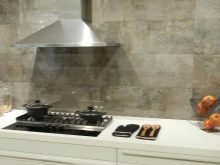
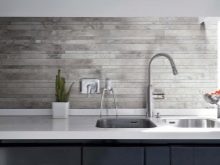
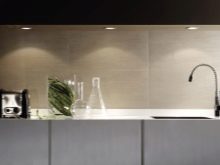
Tiles made from real stone have a very stylish look. Using this cover for the apron, you can literally transform the kitchen. It is hardly reasonable to completely trim it with natural stone mosaic - such a step will absorb too much space. In addition, there will be a visual overflow of one material. It is almost impossible to correct both shortcomings without a new overhaul, therefore, most often they are limited to the use of stone in the decoration of the apron, sometimes they also capture the tabletop, but not more.

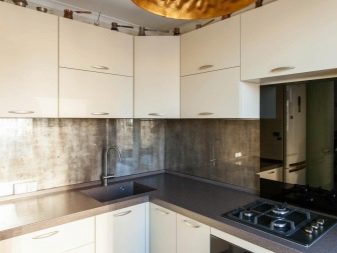
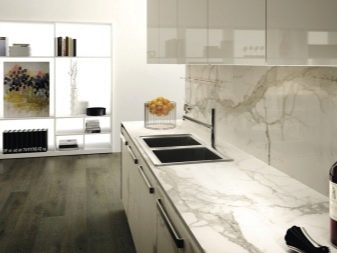

Popular formats
Having chosen the coating material, one must immediately assess the required dimensions. The best option is a multiple in relation to the overall dimensions of the apron. In this case, the need to cut the tiles will be minimized. If the project is drawn up professionally, you don't have to cut anything at all. The typical height of the aprons varies from 50 to 60 cm, but at the same time, one must remember that the cover must go 1-2 cm under all the lockers.
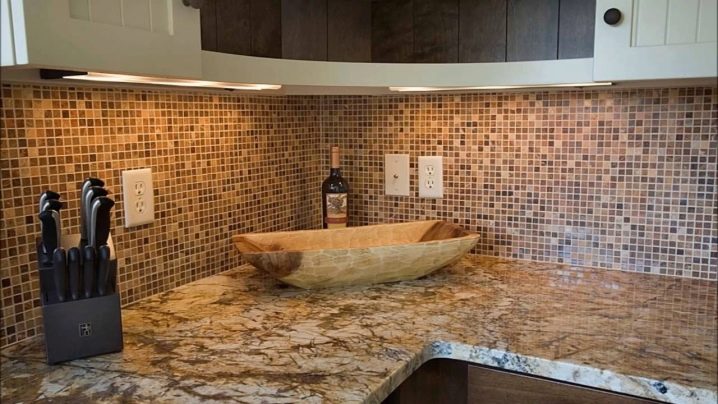
Aprons are always made higher near gas and electric stoves than in the work area. After all, an extractor hood is always present in this place. Relatively small finishing tiles 10x10 cm are very popular. It is she who is first of all considered when choosing material for a kitchen apron. This priority is not surprising: material with such dimensions is least likely to have to be cut, which has a beneficial effect on the timing and effectiveness of the repair, and on the type of composition being created.
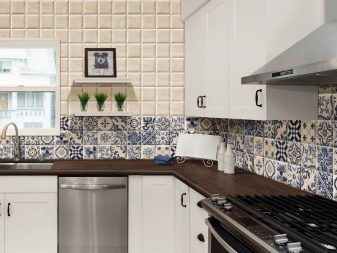

Small tiles are quite appropriate in small kitchens. When used skillfully, it helps to expand the territory. Importantly, the feeling of the harmony of the sizes of tiles and small headsets is not lost. In addition, small decoration blocks are better than large ones when it comes to cladding hard-to-reach areas. A successful combination with panels and decorative materials of a different kind is ensured.
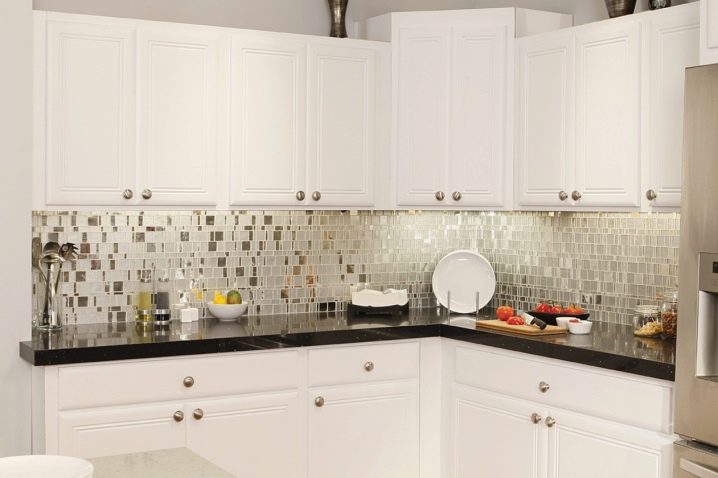
But the disadvantage of small finishing blocks is that they are not easy to lay. Even professionals who undertake such a task are sure to charge an increased fee for their services. You also need to remember that when laying out large products, you will have to create fewer seams. And each seam inevitably becomes a weak point in the structure.
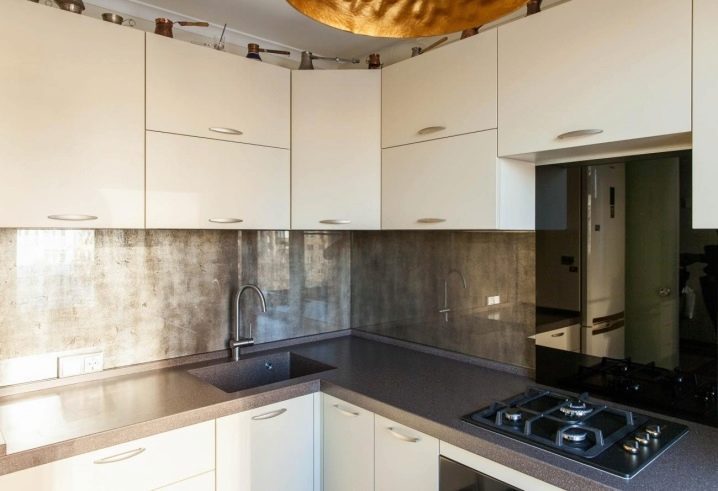
Quite a large number of manufacturers offer other dimensions:
10x20 cm;
20x20;
20x30;
30x30;
30x40 cm.
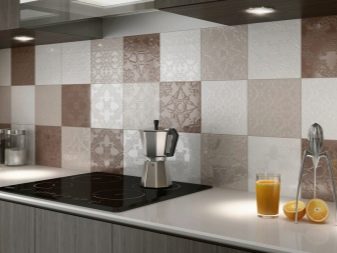
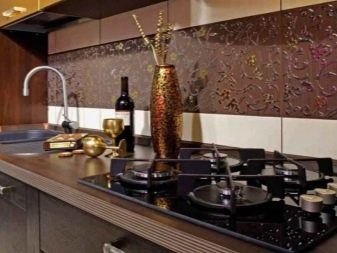
Some of these blocks are equipped with special slots.Therefore, styling is noticeably simplified. Each manufacturer offers different sizes. Although the difference between them is sometimes limited to a few millimeters, it still directly affects the calculation of the required number of tiles.
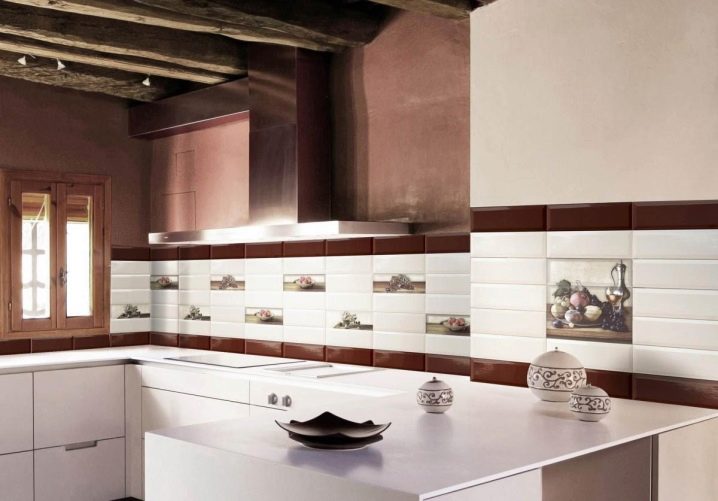
Tiles of the "hog" format have become quite widespread. This name was given to rectangular tiles with beveled bevels. Their geometry is as close as possible to small bricks. If you use this material, you can perfectly decorate both old-fashioned and modern kitchen rooms. In addition, the "hog" helps to externally expand the space. This tile is found in the following dimensions:
7.5x15 (the most common option);
10x20;
6.5x12;
10x25;
8.5x28.5;
15x45 cm.
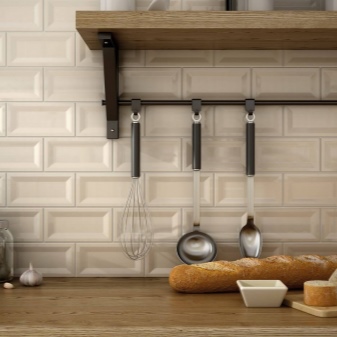

The overwhelming majority of the "hog" blocks are colored in one color. They almost always have a glossy sheen. Usually a calm tonality is chosen, but its saturation can vary significantly. Over 90% of consumers stop at the white "hog". Optionally, you can add elegant decors with images created by photo printing.
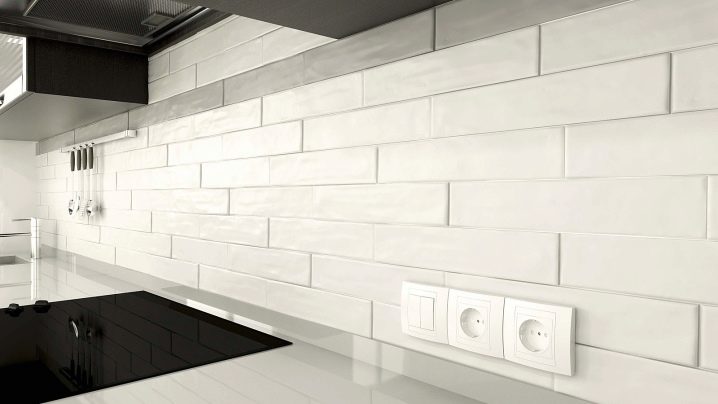
A good alternative to bricks can be a mosaic imitation. Such a solution looks very good, unlike a true mosaic, it does not differ in capriciousness in laying and takes very little time when cleaning. It is based on classic ceramics. However, its outer surface must reproduce mosaic matrices. It is better if their appearance is imitated due to deep-going slots.
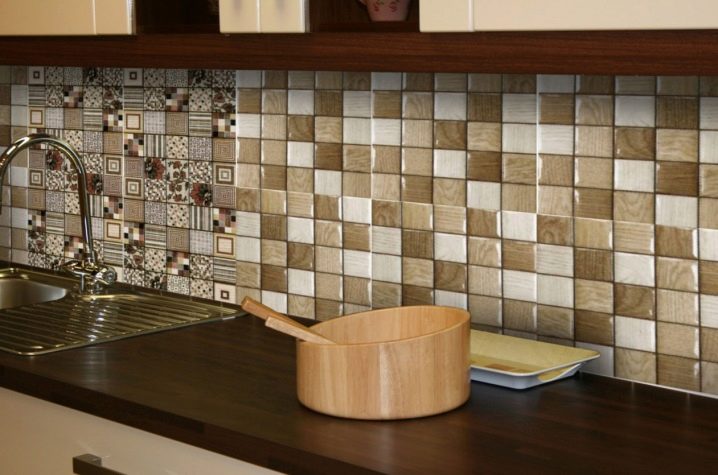
Simple, medium-sized ceramics are a rare "guest" on kitchen walls. This material requires active pruning. Otherwise, it is not possible to provide a beautiful appearance and at the same time fit the coating into the dimensions. If, nevertheless, such a decision is made, it is advisable to choose tiles that are monotonous or covered with a very light pattern. A very large material should be discarded when decorating relatively small rooms.

Design and style options
The design of a kitchen apron in a modern style is very often practiced. It is in good harmony with the similar design of the entire kitchen. In this case, one-color blocks or blocks with an unexpressed pattern are used. Tiles with a photographic image or mosaic compositions also bring good results. It is worth considering ideas using medium format products covered with photographs or bright graphics.
If the kitchen is decorated in a classic spirit, it is useful to trim the backsplash with tiles imitating natural stone. The choice is huge: you can imitate granite, marble and other surfaces. Alternatively, opt for a sleek version with a classic look. Imitations of antique ornaments will look pretty good on such a surface. Some designers advise using tiles in neutral colors that do not have any decor.
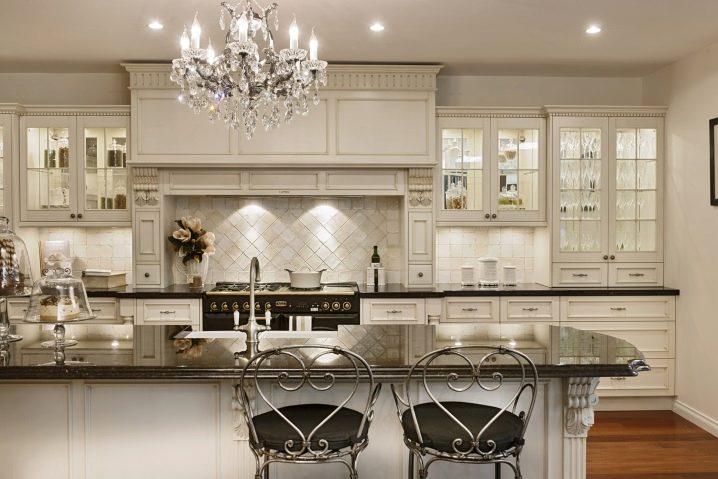
The style of country or Mediterranean Provence becomes a pleasant addition to the kitchen, designed to resemble an old country room. In this case, it is not necessary to decorate the apron with a brick. Reproduction of natural stone becomes a good option. Sometimes ceramic panels are used to decorate kitchens. In some cases, good results are yielded by a mosaic made of 5x5 cm pieces, to which decorative inserts and embossed ornaments are added.
When choosing budget options for an ornament, you should pay attention to the patchwork. Its essence lies in the fact that a woven fabric sewn from dissimilar pieces is imitated. In most cases, the drawing is built according to a geometric scheme. Patchwork style is appropriate mainly in vintage, Arabic (oriental) style, in Mediterranean style. It is recommended to use small or medium tiles for this purpose.
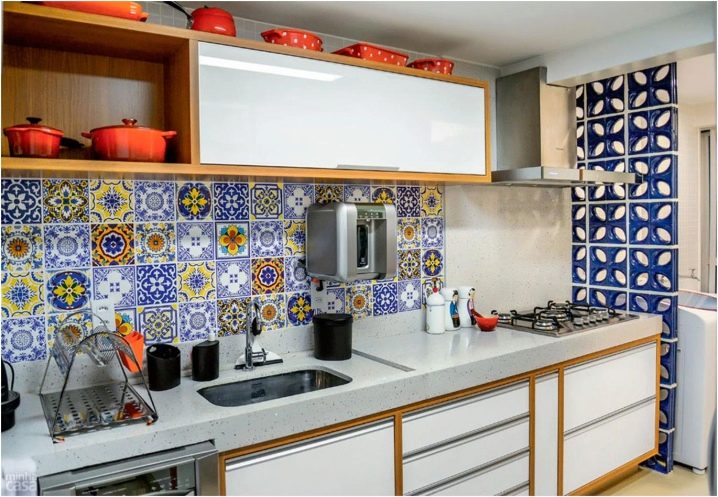
The maximum sophistication with the help of such an apron can be demonstrated in the kitchen-living room, if we focus on the combination of silver, gold and sand tones.It is recommended to use thin grout joints. If imitating antique decor, you can combine blue, gray and pearl tones. For a refined and noble look, it is recommended to use paints such as azure, ocher and indigo. A combination of areas with different color saturation is allowed.
The 3D tiles look very unusual thanks to the carbon film. In many cases, three-dimensional drawing is done using a raster or abstract technique. It is worth remembering that such material is sometimes not perceived very well and it will not be equally useful in every room. Before buying, you need to make sure that the interior does not become too complicated, that it will not be devoid of harmony.

Based on experience of use, 3D tiles are especially good where there is an acute shortage of free space. The visual expansion of the space is of great benefit. To exclude mistakes, it is necessary to carefully select the texture of the material, take into account how it will look. 3D tiles cannot be cut. For grouting, it is allowed to use only colorless silicone-based sealants.
There should not be any special difficulties with the design of the apron for the kitchen, designed in high-tech style. In this case, the use of metal tiles is recommended. It looks original and creates "the very" impression that is required. Sometimes you can lay out a black apron. Surrounded by white facades, it will be perceived organically and will not create unnecessary problems.
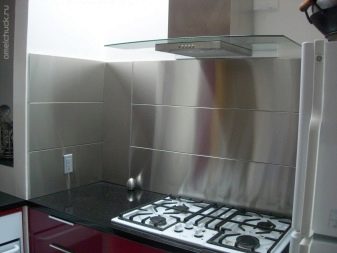

To show originality, the layout of two-color compositions is rarely practiced. Occurrences of another that interrupt the monotony of one color will look decent if they begin to alternate rhythmically. Of course, since the selection is due to color, it is better to refuse to experiment with shape and relief. It has long been known that this will only provoke visual overload. At first, perhaps, such a kitchen will look attractive, but soon it will get bored.
You can often find interiors where the kitchen backsplash is lined with tiles, alternating randomly. But in reality, this is just the result of the work of experienced designers. Non-professionals are unlikely to be able to “hide” harmony in the seeming chaos so cleverly. Therefore, when decorating the kitchen yourself, it is better to choose simpler and more obvious options.
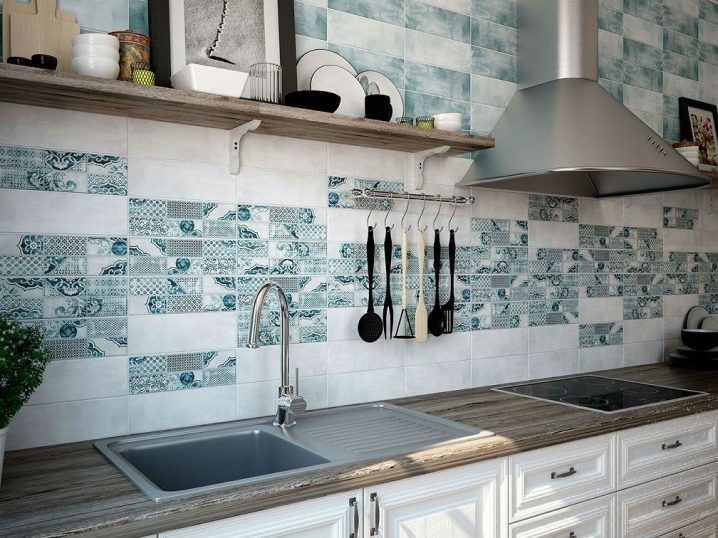
In an Art Deco kitchen, you can use both simple and fanciful looking tiles. The main thing is that it is painted in a monotonous color. If an eclectic composition is created, the choice is even wider. You can lay out the apron from traditional white blocks and from imitation of multi-colored mosaics. The main thing is to maintain compatibility with the external environment (but contrast is not an end in itself, but a way to ensure such compatibility).
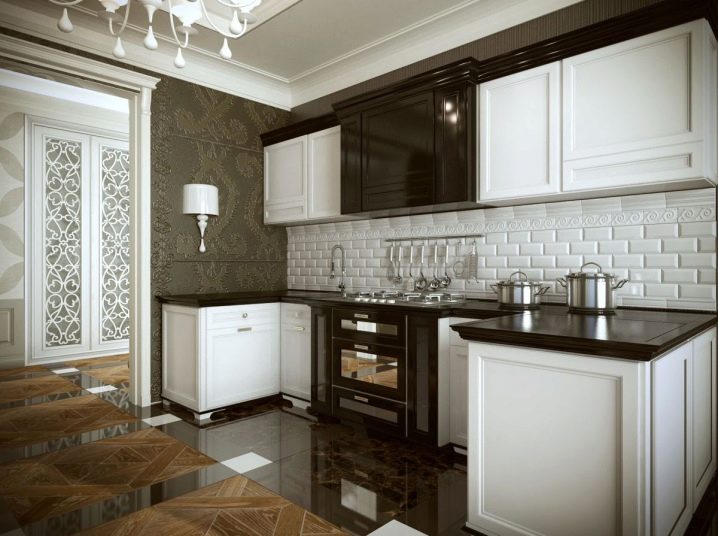
When choosing tiles that correspond to the canons of ethnic styles, you should pay attention to:
suitable colors;
conformity to the cultural image;
using only ornaments and geometric solutions typical for each tradition.
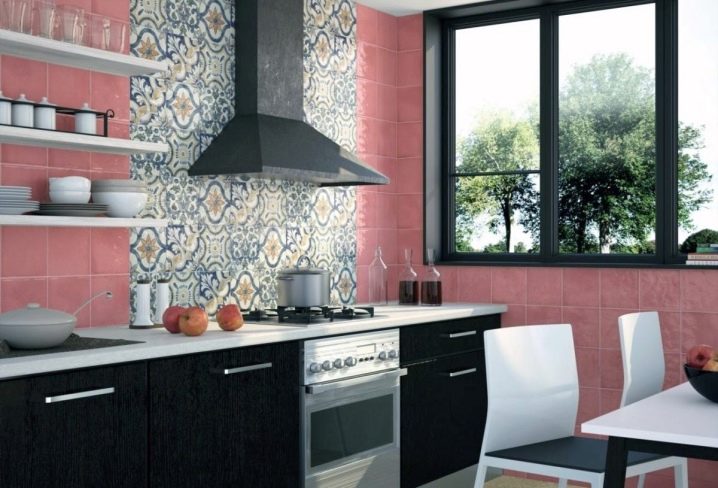
Top manufacturers
As practice shows, domestic tiles for a kitchen apron are no worse than imported counterparts. Russian and Belarusian firms operating in this segment supply mainly inexpensive and moderately expensive products. Importantly, in the 2010s, the quality of decorative items in the Russian Federation and the Republic of Belarus has become significantly higher than before. The production equipment is constantly updated, the latest technologies are actively used. A number of collections, extraordinary in terms of design characteristics, have been developed.
Compared to Italian tiles, products "Uralkeramika", "Nephrite-Ceramics", "Shakhtinskaya tile", "Keramina" and a number of other companies are somewhat less luxurious. Until now, there is a lag in the brightness of colors, in the accuracy of dimensions, in the saturation of the assortment. However, Russian firms are gradually closing this gap.In addition, their products are much more attractive for economic reasons. Attention should be paid to Chinese products as well.
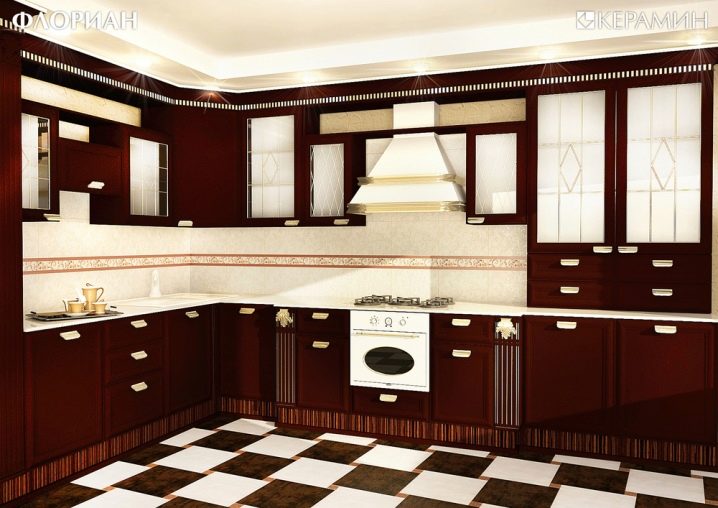
Almost all of them belong to the group of mosaics and tiles imitating it. Chinese manufacturers still hardly export classic tile materials. Apparently, the main reason for this is poor quality. By choosing the finishing material as carefully as possible, you can make a very high-quality apron from Chinese blocks. Polish factories can also offer a number of extraordinary options.
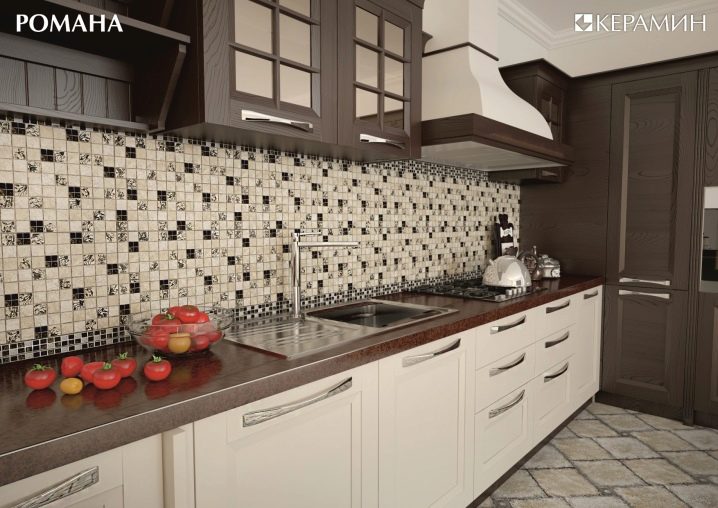
The most expensive products are supplied from Italy. Specialists from the Apennine Peninsula know perfectly well how to create tiles of unusual shapes and atypical colors.
Firms in Spain have long established the production of high-quality tiles of moderately saturated colors. Many Spanish collections are imitations of wood or natural stone. Almost any collection is richly rich in decorative elements. With the help of various borders, inserts and panels, you can create an exclusively original composition. Attention should be paid to the products of such European companies as:
Carmen;
Dune;
Mayolica;
Perona;
Natucer;
Arkadia;
Cerim;
Lafaenza;
Tonalite.
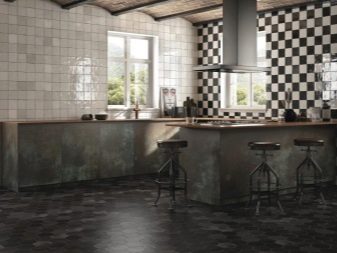
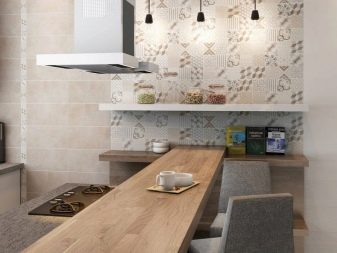
How to choose?
To decorate the kitchen walls, it is necessary to use only coatings resistant to aggressive substances. This is especially important for laying on a lower apron. After all, it is he who comes closest to the stove and becomes more dirty. It is worth remembering that even one model belonging to different batches may have slightly different shades. The reason is simple: it is not always possible to withstand strictly identical conditions during firing.
All that the consumer can do with this is only to carefully monitor the color marking on the purchased packages. Be sure to check the size of the blocks. The glaze performance should be assessed directly in the store. Any scuffs are categorically unacceptable. Moreover, it is worth abandoning the purchase of products that have chips or small cracks.
For a gray kitchen, painted (with a pattern) or tiles imitating natural stone are recommended. Its color is selected to your taste. Imitation of bricks and skins of different tones are also acceptable. Adding a variety of accents helps to avoid the feeling of facelessness. But still the most complete solution is a white tile backsplash.
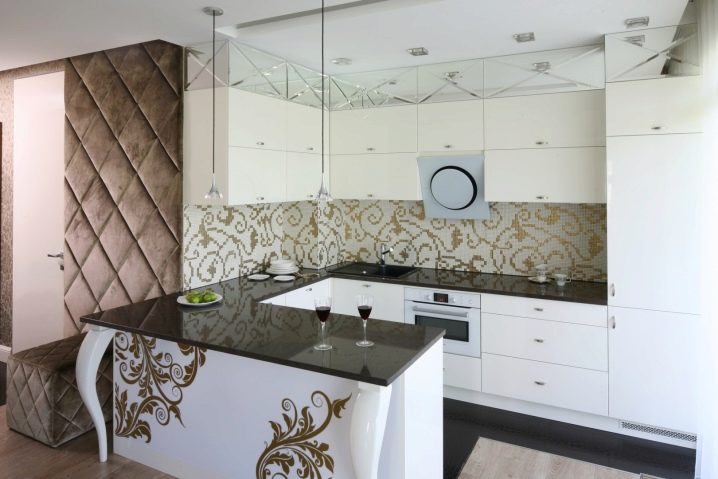
Laying methods
Laying the tiles correctly in the apron is just as important as choosing it. First, you should estimate the size of the covered area and set the required amount of material. In the absence of experience, it is recommended to use the basic installation technique. It allows you to minimize the waste of building material. But since deformation, chips and other excesses are still likely, it is necessary to immediately purchase 10% more goods than follows from the calculations.
Starting from the center, the cut tiles will have to be placed from the edge. As a result, on the right and on the left, they should have the same size. If this requirement is not met, it will not work to make a neat apron. It is better to set the horizontal level with a flat bar. Plasterboard sheets or a metal profile will serve as a good replacement for it.
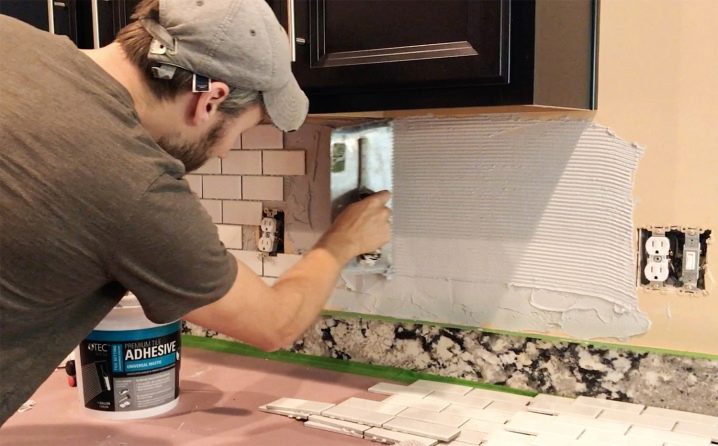
After finishing the markup, you need to make a glue solution. This must be done strictly according to the standard recipe. The use of self-adhesive tiles allows you to simplify the process by avoiding this step. A solution prepared incorrectly will quickly be destroyed. Once dry, it is also unusable.
In the absence of experience, it is advisable to lay an apron from large tiles. The glue is applied with a narrow spatula. It should be distributed over the surface in a strictly uniform layer. There must be furrows. It is worth experimenting with applying glue to the tile itself.
In both cases, you should thoroughly press the tile and achieve uniform shrinkage of the composition. The tile is applied and pressed on it evenly over the entire area.By tapping the entire surface consistently with a rubber mallet, adhesion is increased. Laying the tiles from the edge, at the same time as this step, the corner is mounted. Each row is checked using a level so that the vertical and horizontal lines are strictly adhered to.
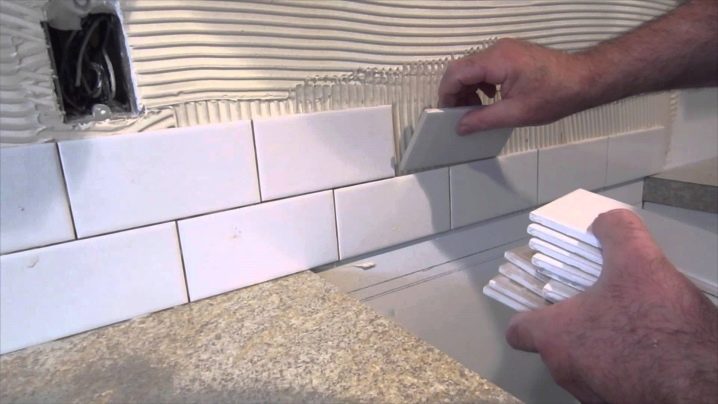
Interesting examples
It would be possible to talk for a long time about specific methods and nuances of styling, about other subtleties. But it is much more useful to see what examples of tiling an apron can be in practice. Then it will become clear what is worth striving for. For example, white tiles with a light beige tint can be a good addition to the kitchen, where furniture has exquisite brown facades. Importantly, the same tiles were used for the countertop; an attractive light panel with plant motifs will appeal to almost all owners.
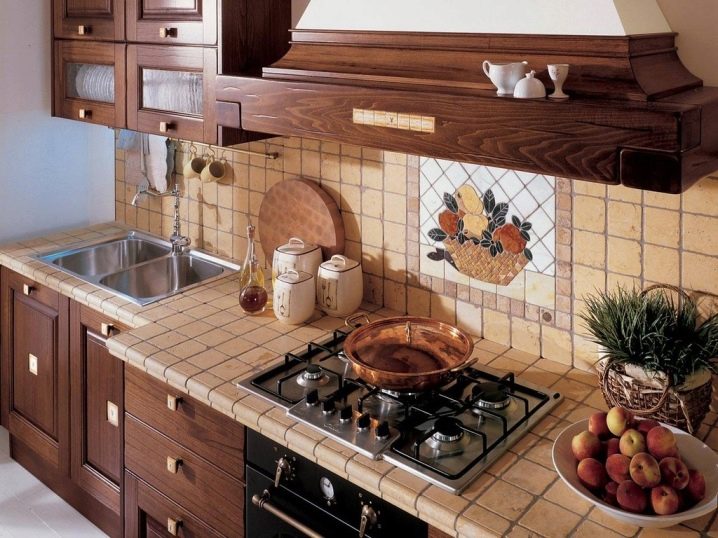
A patchwork tile arrangement will look stylish and fun in a bright and well-decorated kitchen. The use of elements of bright color in the rest of the decor should be such that it does not create a feeling of inconsistency and so as not to distract attention from the main part of the composition. If the interior is more congested, this solution is hardly suitable in practice. Then you can use light yellow tiles, not laid directly, but in the form of peculiar paths.
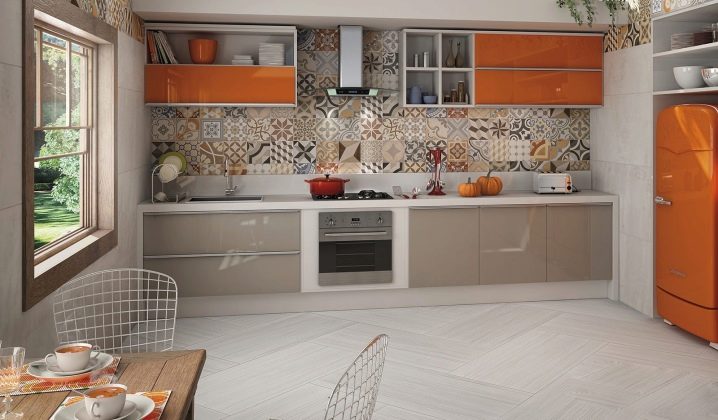
For professional designers, it is not difficult to choose the right composition when decorating a very light kitchen with a checkerboard floor. They can offer, for example, an imitation of a full-fledged brick wall. Laying of "bricks" is carried out with a shift of the rows relative to each other. Grouting is done in such a way that it does not draw attention to itself. For space zoning, it is advisable to use local lighting.
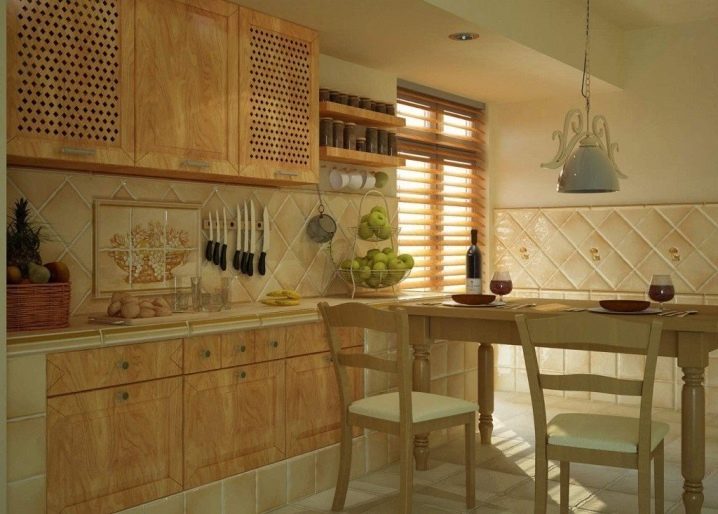
But you can do it differently. Tiled compositions look very original when instead of rows the tiles are laid out differently. At the same time, the pronounced blue color of the blocks themselves, in combination with lighter seams, makes it possible to further improve the impression. Individual tiles are always embossed, which adds charm to the composition. In a kitchen where color accents are abundant, this solution is perfect.
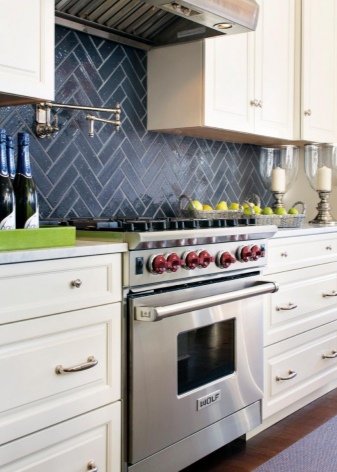

How to lay an apron in the kitchen in 10 minutes, see the video below.













The comment was sent successfully.